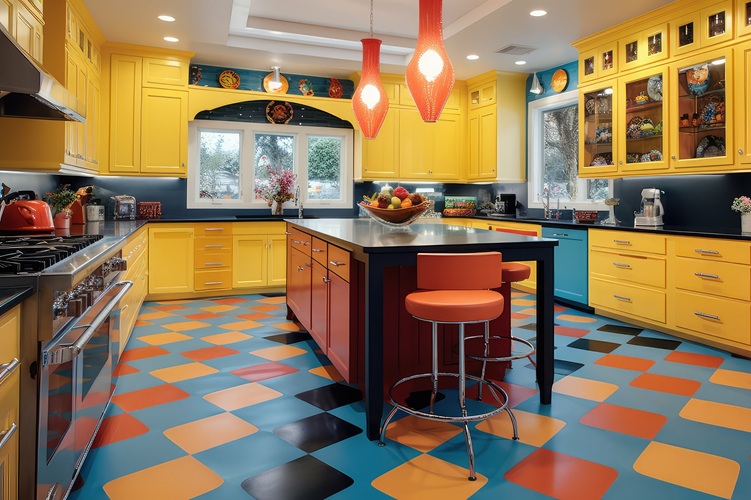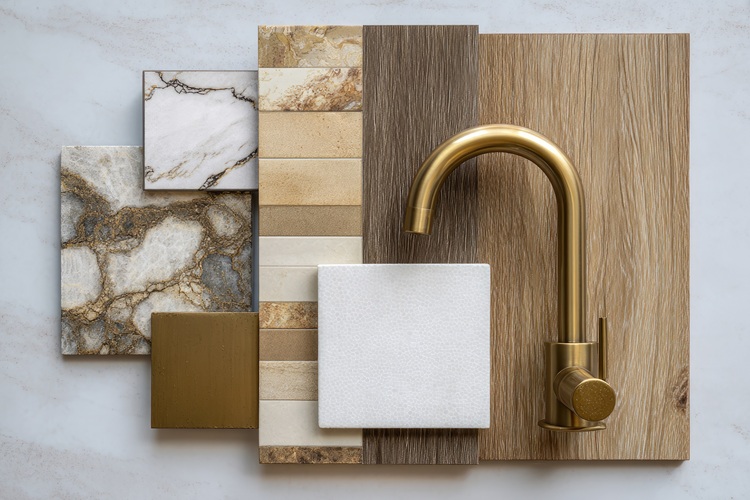The kitchen is one of the hardest-working areas in any home. It’s where meals are made, conversations happen, and life tends to gather. o, when you think about flooring, it needs to be more than good-looking. It should hold up well, be easy to clean, and still match the style of your space. With the right tiles, you can create a kitchen that’s not only practical but also a pleasure to walk into.

Clean Lines for Modern Kitchens
If you’re working with a modern kitchen, you’re likely after a clean, clutter-free look. Large size tile works well in this setting. It cuts down on grout lines and helps the room feel open and less busy. Stick to simple tones with matte options, nothing too glossy or loud.
Some homeowners add contrast with warm wood accents or metal fixtures, but the flooring stays quiet and steady. Concrete-look tiles or soft natural stone tiles can bring in texture without drawing too much attention. It’s a subtle way to add depth to the room without competing with the rest of the design.
You’ll find plenty of porcelain tile flooring ideas that work well in this type of kitchen, especially in a polished porcelain finish if you want a cleaner, more refined surface. Porcelain tiles are durable, easy to clean, and available in finishes that mimic stone, wood, or cement. It’s a smart pick if you want something that looks good and holds up over time.
Warm Touches for Farmhouse and Rustic Kitchens
A farmhouse kitchen is all about comfort and warmth. The floors should feel like they belong, something that adds to the charm without looking too polished. Tiles with a natural or weathered look fit this style well. Soft browns, muted grays, or clay tones give the space a welcoming feel.
You don’t need anything too perfect. In fact, small variations in tone or surface make the floor feel more lived-in. That’s where natural stone tiles like limestone-look ceramics or travertine mosaics work well. They bring in natural texture without the upkeep of real stone.
For layout, go with a staggered brick or traditional installation pattern. This keeps things relaxed but visually interesting. In farmhouse kitchens with open shelving and vintage fixtures, warm-toned floor tile patterns help tie the room together.

Bright Ideas for Small Kitchens
In smaller kitchens, tile flooring needs to do more. It should make the room feel open while still standing up to daily use. Lighter-colored kitchen floor tiles help reflect light and make tight spaces feel bigger. Stick to simple layouts like grid or horizontal stack patterns to keep the design clean.
Larger tiles are also a smart choice. They create fewer grout lines, which helps the floor look smoother and less crowded. If you want a bit of pattern, a soft herringbone pattern in a light tone adds movement without making the room feel too busy.
Grout color matters more than most people think. A grout that matches your tile can create a seamless look, while a slightly darker grout helps hide dirt. Either way, keeping it simple and clean helps the rest of your kitchen stand out.
Pattern and Color for Eclectic Kitchens
If your style leans more eclectic, don’t shy away from bold tile choices. Patterned or colorful tiles can bring energy into the kitchen, especially if the rest of the space is kept simple. You don’t have to tile the whole floor. Sometimes, it’s more effective to highlight one area.
There’s no shortage of bold floor tile designs to choose from. Checkerboard tiles in black and white offer a vintage feel that always gets noticed. Or try patterned geometric tiles to bring a modern twist to the space. They work especially well when balanced with simple cabinetry.
If you’re aiming for something playful but not too loud, consider using unexpected tile shapes like hexagons or diamonds. You could even mix in penny mosaics or travertine mosaics to break up larger fields of tile and add character.
Understated Style for Classic Kitchens
Classic kitchens often stick to soft tones, timeless shapes, and traditional layouts. Floor tiles patterns in soft grays, warm whites, or stone-inspired finishes blend in well and don’t compete with the rest of the room.
Go with a straightforward layout like a grid or gentle offset pattern. It gives a tidy, pulled-together look. If you want to add a touch of texture, tiles with a soft vein or a lightly brushed surface can do the trick without calling too much attention to themselves.
You can also use tile shapes to add subtle variation. Rectangles, squares, or a classic herringbone pattern can bring a timeless element that feels clean and familiar. This creates definition without breaking the calm and helps bring the look of your dream kitchen together in a clean, effortless way.
Final Thoughts
Tile flooring is one of the smartest updates you can make in the kitchen. It’s practical, durable, and offers more style options than most people realize. With so many floor tile designs, color choices, shapes, and finishes to choose from, there’s something for every kitchen style.
Think about the kind of space you want to walk into every day. If the floor can take the daily mess and still look good doing it, then you’ve made the right call.
